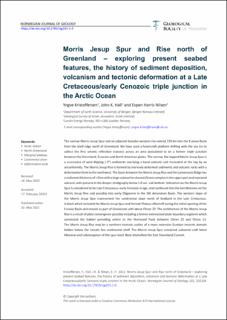| dc.contributor.author | Kristoffersen, Yngve | |
| dc.contributor.author | Hall, John K. | |
| dc.contributor.author | Nilsen, Espen Harris | |
| dc.date.accessioned | 2022-04-04T12:18:26Z | |
| dc.date.available | 2022-04-04T12:18:26Z | |
| dc.date.created | 2022-02-02T10:52:23Z | |
| dc.date.issued | 2021 | |
| dc.identifier.issn | 2387-5844 | |
| dc.identifier.uri | https://hdl.handle.net/11250/2989645 | |
| dc.description.abstract | The narrow Morris Jesup Spur and an adjacent broader western rise extend 220 km into the Eurasia Basin from the shelf edge north of Greenland. We have used a hovercraft platform drifting with the sea to collect the first seismic reflection transect across an area postulated to be a former triple junction between the Greenland, Eurasian and North American plates. The narrow, flat-topped Morris Jesup Spur is a succession of west-dipping (? 3°) sediments overlying a basal volcanic unit truncated at the top by an unconformity. The Morris Jesup Rise is formed by intensely deformed sediments and volcanic rocks with a deformation front to the northwest. The basin between theMorris Jesup Rise and the Lomonosov Ridge has a sediment thickness of >3 km with a large submarine channel/levee complex in the upper part and repeated volcanic units present in the deeper stratigraphy below 1.0 sec. sub-bottom. Volcanism on the Morris Jesup Spur is considered to be Late Cretaceous–early Cenozoic in age, and continued into the late Miocene on the Morris Jesup Rise and possibly into early Oligocene in the SW Amundsen Basin. The western slope of the Morris Jesup Spur represented the continental slope north of Svalbard in the Late Cretaceous. A block which included the Morris Jesup Spur and Yermak Plateau rifted off during the initial opening of the Eurasia Basin and moved as part of Greenland until about Chron 22. The architecture of the Morris Jesup Rise is a result of plate convergence possibly including a former extensional plate boundary segment which connected the Gakkel spreading centre to the Hornsund Fault between Chron 22 and Chron 13. The Morris Jesup Rise may be a northern tectonic outlier of a more extensive Eurekan tectonic domain hidden below the Lincoln Sea continental shelf. The Morris Jesup Spur remained subaerial until latest Miocene and submergence of the spur most likely intensified the East Greenland Current. | en_US |
| dc.language.iso | eng | en_US |
| dc.publisher | Geological Society of Norway | en_US |
| dc.rights | Navngivelse 4.0 Internasjonal | * |
| dc.rights.uri | http://creativecommons.org/licenses/by/4.0/deed.no | * |
| dc.title | Morris Jesup Spur and Rise north of Greenland – exploring present seabed features, the history of sediment deposition, volcanism and tectonic deformation at a Late Cretaceous/early Cenozoic triple junction in the Arctic Ocean | en_US |
| dc.type | Journal article | en_US |
| dc.type | Peer reviewed | en_US |
| dc.description.version | publishedVersion | en_US |
| dc.rights.holder | Copyright the authors | en_US |
| dc.source.articlenumber | 202104 | en_US |
| cristin.ispublished | true | |
| cristin.fulltext | original | |
| cristin.qualitycode | 1 | |
| dc.identifier.doi | https://dx.doi.org/10.17850/njg101-1-4 | |
| dc.identifier.cristin | 1996840 | |
| dc.source.journal | Norwegian Journal of Geology | en_US |
| dc.identifier.citation | Norwegian Journal of Geology. 2021, 101 (1), . | en_US |
| dc.source.volume | 101 | en_US |

